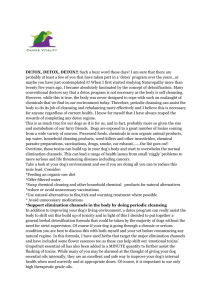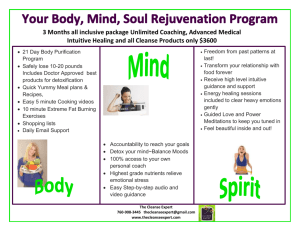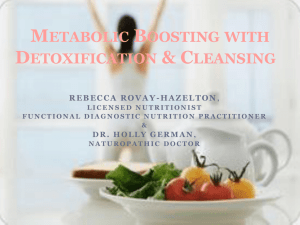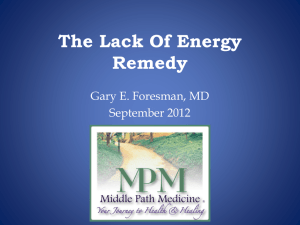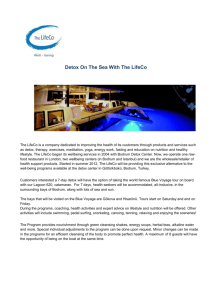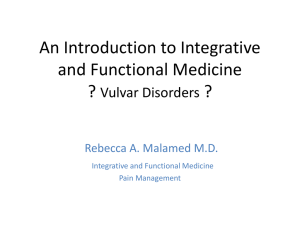File - Michael E. Greer, MD
advertisement
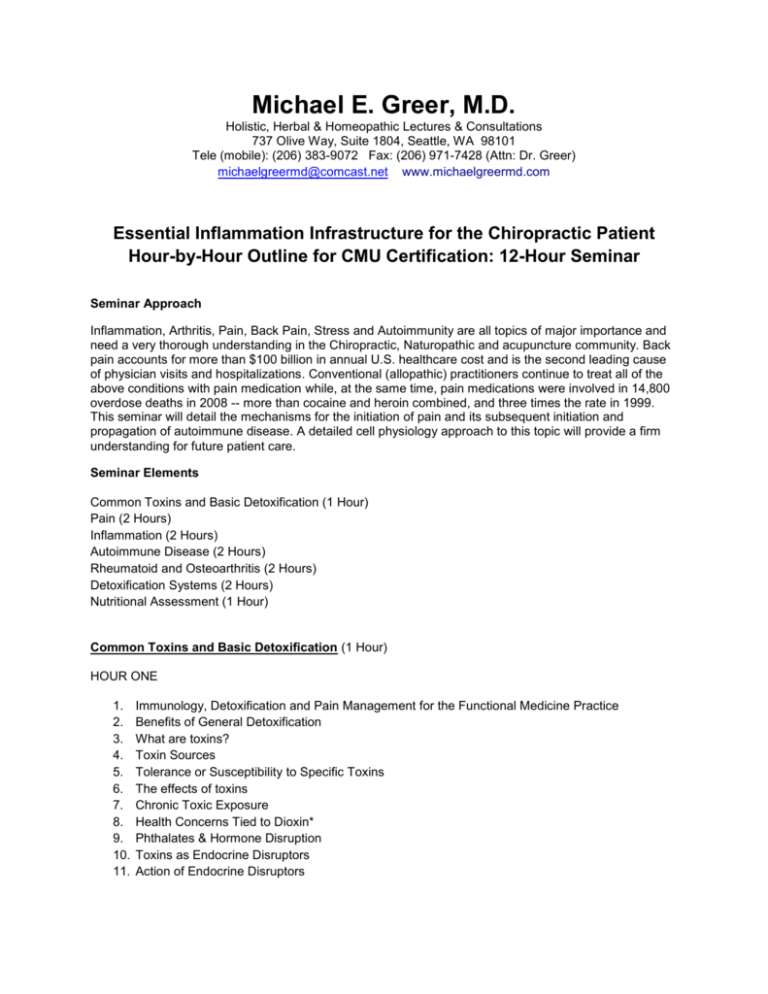
Michael E. Greer, M.D. Holistic, Herbal & Homeopathic Lectures & Consultations 737 Olive Way, Suite 1804, Seattle, WA 98101 Tele (mobile): (206) 383-9072 Fax: (206) 971-7428 (Attn: Dr. Greer) michaelgreermd@comcast.net www.michaelgreermd.com Essential Inflammation Infrastructure for the Chiropractic Patient Hour-by-Hour Outline for CMU Certification: 12-Hour Seminar Seminar Approach Inflammation, Arthritis, Pain, Back Pain, Stress and Autoimmunity are all topics of major importance and need a very thorough understanding in the Chiropractic, Naturopathic and acupuncture community. Back pain accounts for more than $100 billion in annual U.S. healthcare cost and is the second leading cause of physician visits and hospitalizations. Conventional (allopathic) practitioners continue to treat all of the above conditions with pain medication while, at the same time, pain medications were involved in 14,800 overdose deaths in 2008 -- more than cocaine and heroin combined, and three times the rate in 1999. This seminar will detail the mechanisms for the initiation of pain and its subsequent initiation and propagation of autoimmune disease. A detailed cell physiology approach to this topic will provide a firm understanding for future patient care. Seminar Elements Common Toxins and Basic Detoxification (1 Hour) Pain (2 Hours) Inflammation (2 Hours) Autoimmune Disease (2 Hours) Rheumatoid and Osteoarthritis (2 Hours) Detoxification Systems (2 Hours) Nutritional Assessment (1 Hour) Common Toxins and Basic Detoxification (1 Hour) HOUR ONE 1. 2. 3. 4. 5. 6. 7. 8. 9. 10. 11. Immunology, Detoxification and Pain Management for the Functional Medicine Practice Benefits of General Detoxification What are toxins? Toxin Sources Tolerance or Susceptibility to Specific Toxins The effects of toxins Chronic Toxic Exposure Health Concerns Tied to Dioxin* Phthalates & Hormone Disruption Toxins as Endocrine Disruptors Action of Endocrine Disruptors Pain (2 Hours) HOUR TWO Estrogen Hydroxylation and Its impact on Inflammation or Anti-Inflammation 1. 2. 3. 4. 5. 6. 7. 8. 9. 10. 11. 12. 13. 14. 15. Epigenetic Carcinogens Emerging Importance of Epigenetics Transgenerational Epigenetic Effect of Famine Exposure Methods of Detox Detoxification via the Extracellular Matrix (ECM) The Extra-cellular Matrix Communication Signals via Cytokines Toxins & their effects on our cells & hormones Fat cells & Toxins Detoxification & Drainage Relationship of Estrogens + Cortisol Estrone vs. Estradiol Estrone (E1) Importance of 2-Hydroxyestrone Indole-3-carbinol (I3C) & 3,3'-Diindolylmethane (DIM) HOUR THREE Estrogen Dominance from Sex Hormone Binding Globin (SHBG) Disruptors 1. 2. 3. 4. 5. 6. 7. 8. 9. 10. 11. 12. SHBG Fat Cells Transcortin SHBG controlling factors Polychlorinated Bisphenyls (PCBs) Bisphenol-A: An Estrogen-Like Effect BPH Incidence of Prostate Cancer Chlorinated Pesticides: Effect on the Nervous System DDT’s Estrogenic Effects Formaldehyde Linked to Reduced Fertility Low Level Lead, Mercury & Arsenic: Endocrine Disruptors Inflammation (2 Hours) HOUR FOUR Communication of the Cytokines in the Extracellular Matrix 1. Cell to cell communication 2. Pain Modulation at a Cellular Level 3. Different cells and their role in pain and inflammation 4. 5. 6. 7. 8. 9. 10. 11. 12. Function of TGF-B Inflammation and repair Pro Inflammatory Cytokines Immune system cells: DCs Immune system cells: NK cells Detoxification at a Cellular Level The Extra-cellular Matrix Current views on the Microenvironment The relationship between inflammation and immune cell response HOUR FIVE Pain Modulation and Inflammation Repair at a Cellular Level 1. 2. 3. 4. 5. 6. 7. 8. 9. 10. 11. Auto-Regulating System (ARS) ARS Approach for Pain & Anti-inflammatory Resolution Therapeutic Considerations & Consequence Importance of Antigen Concentration Mechanism of Immune Regulation: The Bystander Reaction T-cell Physiology Cellular Modulation Medication Choices Conventional medicine inflammation approach Chronic Inflammation & Associated Diseases Autoimmune Disease (2 Hours) HOUR SIX The Autonomic Regulatory System and T Cell Physiology 1. 2. 3. 4. 5. 6. 7. 8. 9. 10. 11. 12. 13. 14. Conventional Medical Approach to Inflammation T Cells vs B Cells Molecular Immunology Basic Immunophysiology Immune system cells: Lymphocytes T-Cells vs. B-Cells The “divine” cytokine The Immune System Overview of the Immune system Immune Reactivity TH-0 Cells TH-1, TH-2, TH-3 Cells Immune system cells: DCs TH-1 vs. TH-2 function HOUR SEVEN Overview of the Immune System with Basic and Molecular Immunophysiology 1. 2. 3. 4. 5. 6. 7. 8. 9. Auto-Regulating System TH-3 Helper Cells Actions of the TH-3 Cell TH-3 (Treg) Regulator Cell TH-3 Cell Induction TH 0, TH 1 and TH 2 TH-1/TH-2 Switch TH-1 Three Factors in Allergic Development: Trigger HOUR EIGHT Insights into Pain Management using Concepts and Medications 1. 2. 3. 4. 5. 6. 7. 8. 9. 10. 11. 12. 13. 14. Detox and Immunomodulation Interactions Insight into Pain Management using Concepts and Medications Conventional medicine inflammation approach Chronic inflammation and associated diseases General concepts: Inflammation Detoxification at a Cellular Level Confirmation for Pain Modulation Toxins & the ECM Movement from storage compartment Toxin Elimination Cortisol Stress and Autoimmunity The “Catch 22” Detoxification Systems (1 Hour) HOUR NINE Adrenal Rhythm and Its Importance to Well Being and Sleep 1. 2. 3. 4. 5. 6. 7. 8. Detox Factors Cortisol Effects in the Matrix Adrenal Rhythm & Its Importance The “Catch 22” Cortisol Common Symptoms of Excess Cortisol Poor Sleep & Insomnia Stress and Immunity Rheumatoid and Osteoarthritis (2 Hours) HOUR TEN Insights into Pain Management Using Concepts and Medications 1. Cortisol: Clinical Manifestations 2. 3. 4. 5. 6. 7. 8. 9. 10. 11. 12. 13. 14. 15. 16. 17. Laboratory Testing that Determines Inflammation and The Need for Detox CRP & IL-6 Predict Death CRP and Dementia Risk Laboratory testing* Common Tests for Markers of Liver Function Detox Factor Regenerating Capacity of the Liver Liver Environmental Influences Role of the Liver Phase I – Phase II The P450 Enzyme Problems With Detox & Fasting Phase I – Phase II Detoxification – Phase I Detoxification – Phase II Toxicity HOUR ELEVEN The Role of the Liver in Detoxification and Inflammation Control 1. 2. 3. 4. 5. 6. 7. 8. 9. 10. 11. 12. 13. 14. 15. 16. Elimination Organs The Route of Toxins Phase II Detox Nutrients Antioxidants for Phase I Detox Ellagic Acid Phase II Pathways Glutathione: The Master Antioxidant Supplements to Optimize Glutathione Antioxidant Activity Glutathione enhancing supplements Detoxification Qualities of Silymarin from Milk Thistle Symptoms of Reduced Liver Function/Damage Other Causes of Liver Dysfunction Enhance Liver Function Supporting the Liver & Its Ability to Detoxify Hepatic Detox Herbs Liver-Supporting Dietary Practices Nutritional Assessment (1 Hour) HOUR TWELVE Whole foods – Mechanisms of Action and Nutritional Immunology 1. 2. 3. 4. 5. 6. Foods Aiding Elimination & Metabolic Cleansing Whole Foods: Mechanisms of Actions General Dietary Liver Detox Guidelines Nutritional immunology Physiology of detoxification: Toxicokinetics Liver and Gallbladder Support 7. 8. 9. 10. 11. 12. 13. 14. 15. 16. 17. 18. 19. 20. 21. Gallbladder Specific Role of the Biliary System Detox Factors Kidney Specific Indications Detox Factors: Lungs Advanced detoxification Detox Factors: Intestine Detox Factors: Epithelial Tissue and Skin Support Skin Inflammation, lymphatic function and dendritic cell migration Clinical application- How Long to Treat Clinical application- If Poor Results The Key Points for Detox The 4-S Regimen to Attack Toxin Accumulation
